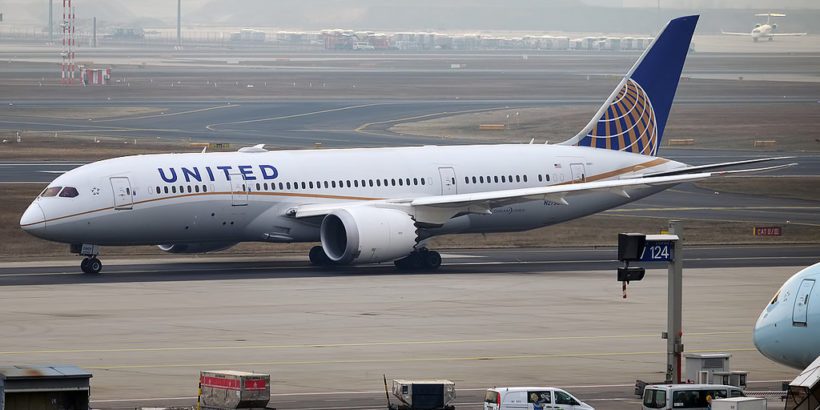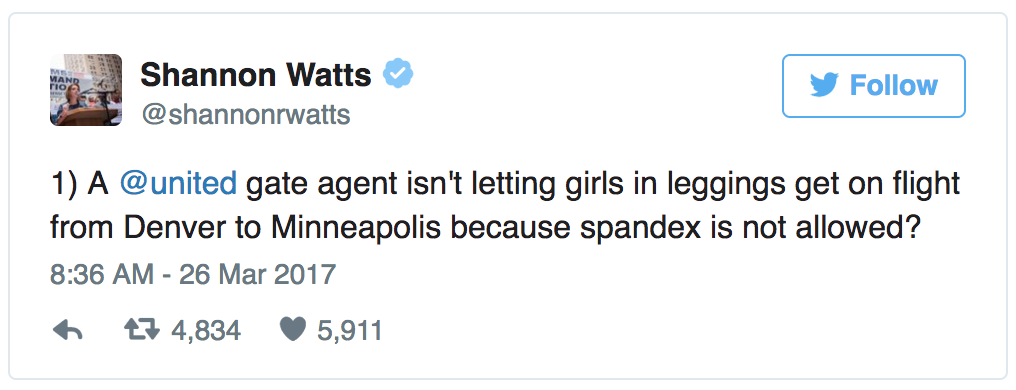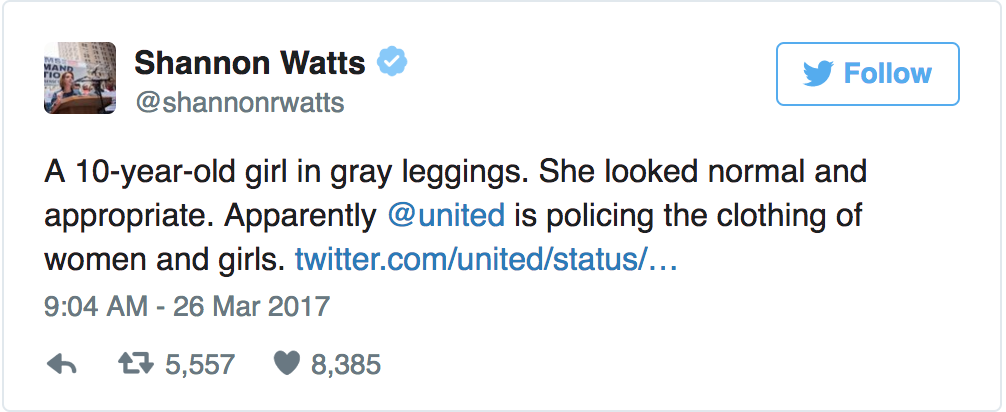What do you get when you a mix a controversial decision related to the clothing of a young girl, an activist with 35,000+ followers, and a poorly managed corporate twitter account? Well, you may want to ask United to find out. Yesterday, United found itself in very hot water after it was reported that the airline denied boarding to two young teenage girls for simply wearing leggings. But as more facts have been revealed, it doesn’t look like United was quite the bully some thought they were.
What happened?
In short, two girls (young women?) were attempting to board a flight from Denver to Minneapolis yesterday but were told that they could not board based on their attire (i.e, the fact they were wearing leggings). Another parent saw that his young girl (girl # 3) was wearing leggings and took proactive measures to ensure she’d be able to board by giving her a dress to put on. Apparently, an activist and founder of a gun control advocacy group, named Shannon Watts saw the situation unfold and tweeted about it. It then went viral.
Trying its best at damage control, United continued to reply to users on Twitter, citing to its “contract of carriage” for justification for its decision.
The problem with United’s response is that the reason the two girls were turned away is that they were boarding on a company benefit travel ticket (United pass). These are those ridiculously low priced fares that employees and family members of airline employees are eligible to take advantage of. However, in order to do so, they must abide by a stricter dress code.
Here’s what the dress code states:
Dress code
- Pass riders’ overall appearance should be well-groomed, neat, clean and in good taste.
- Attire should be respectful of fellow revenue passengers, employees and pass riders.
- Pass riders may wear denim attire (such as jeans), shorts that are no more than three inches above the knee and athletic shoes when traveling in Coach or Business cabin.
The following attire is unacceptable in any cabin but is not limited to:
- Any attire that reveals a midriff.
- Attire that reveals any type of undergarments.
- Attire that is designated as sleepwear, underwear, or swim attire.
- Mini Skirts
- Shorts that do not meet 3 inches above the knee when in a standing position.
- Form-fitting lycra/spandex tops, pants and dresses.
- Attire that has offensive and/or derogatory terminology or graphics.
- Attire that is excessively dirty or has holes/tears.
- Any attire that is provocative, inappropriately revealing, or see-through clothing.
- Bare feet
- Beach-type, rubber flip-flops
CUSTOMER SERVICE’S JUDGEMENT WILL PREVAIL IN ALL MATTERS PERTAINING TO THE DRESS CODE.
As you can see leggings are clearly banned since they would fall in the “Form-fitting lycra/spandex tops, pants and dresses” category. Thus, United was simply enforcing its established policy for company benefit travel in this instance. (The other little girl who put on the dress was not flying with company benefit travel and was thus never told to change.)
There are a couple of problems here that I think are worth mentioning.
Twitter management gone wrong
The first problem is the mismanagement of the United Twitter account. Someone likely didn’t have knowledge of the full set of facts before firing back on United’s Twitter account and citing to the “contract of carriage” for the reason for the ban. That was just flat out misleading and United’s come out and cleared that up by saying that spandex pants are fine for regular paying customers. So much of this mess could’ve been avoided if United had acted more tactfully in their early responses.
Also, United may have considered dealing with the situation at the ticketing booth a bit more privately. I wasn’t there so I’m not sure what they could’ve done differently but some reports are saying that this situation was not dealt with discretely at all and as a result, it led to more embarrassment for all parties involved than might have been necessary.
The policy seems targeted to women
I realize we live in a society where we’re quick to jump on anything and anyone that appears to be engaging in any type of discrimination, especially when it comes to something resembling sexism. For that reason, I try to hear out all of the facts before arriving at a judgment.
In this case, however, it does look like the dress code for company benefit travel is targeted more towards keeping women up to a certain standard than men. For example, there are 5 different criteria that apply overwhelmingly to women, while the others could easily apply to both sexes.
- Any attire that reveals a midriff
- Attire that reveals any type of undergarments.
- Attire that is designated as sleepwear, underwear, or swim attire.
- Mini Skirts
- Shorts that do not meet 3 inches above the knee when in a standing position.
- Form-fitting lycra/spandex tops, pants and dresses.
- Attire that has offensive and/or derogatory terminology or graphics.
- Attire that is excessively dirty or has holes/tears.
- Any attire that is provocative, inappropriately revealing, or see-through clothing.
- Bare feet
- Beach-type, rubber flip-flops
I understand United wants to uphold a certain standard for the passengers riding on these tickets since they are associated (to a degree) with their company. I also understand not wanting these passengers to look raggedy or to come on board half-naked and there’s nothing wrong with that. But not being able to wear an article of (comfortable) clothing that’s probably considered a staple for a young girl or women in general these days just seems excessive.
I don’t know about you, but I’m not going to think “less” of United even if I knew two girls were wearing leggings while traveling on a United pass.
Still, there is some blame that goes to the parents or whoever held the special relationship with United. They should have a duty to inform the passengers that they must abide by a strict dress code in order to take advantage of this benefit. I don’t blame the girls for not knowing about the dress code, but somewhere along the line there’s an adult who could’ve avoided this problem for everyone.
In the end, I think this story is just another story that got blown way out of proportion. In many ways, it was a perfect storm. You had a controversial decision related to the clothing of a young girl, an activist on site to witness it all, and mismanaged (borderline tone-deaf) Twitter use by United. It’s no wonder that this story blew up so badly.
It is good that it’s drawing attention to this dress code that I think is out of date/touch, but I don’t think United was anywhere close to being the evil corporate monster that so many people are looking for. Still, if there’s any lesson United could take from this, it’s how to deal with situations like this with more tact since these scenarios can easily ignite into a media firestorm.
Cover photo by Anna Zvereva via Flickr.
Daniel Gillaspia is the Founder of UponArriving.com and the credit card app, WalletFlo. He is a former attorney turned travel expert covering destinations along with TSA, airline, and hotel policies. Since 2014, his content has been featured in publications such as National Geographic, Smithsonian Magazine, and CNBC. Read my bio.




